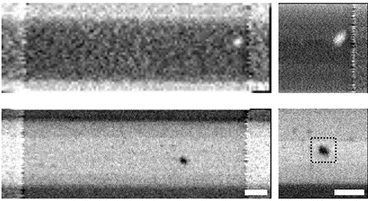Topological magnetic quasi-particles, such as the magnetic skyrmion, are a promising candidate as encoders for digital information in novel memory concepts, such as the magnetic racetrack memory. However, a major challenge towards the development of such devices is given by the relatively low skyrmion velocities when displacing them with electrical currents, the presence of pinning sites hindering their motion, and the presence of the so-called skyrmion Hall effect, causing an unwanted lateral movement of the magnetic skyrmions combined with their forward motion under an applied electrical current. All of these effects are particularly pronounced for skyrmions stabilized in ferromagnetic heterostructures, therefore encouraging the study of magnetic skyrmions in ferrimagnetic systems, where the lower total magnetic moment of the system promises a reduction of the unwanted effects described above.
In this work, published in the journal Nano Letters, scientists from a joint international cooperation between the New York University and the Swiss Light Source, have investigated the nucleation and motion of skyrmions in a ferrimagnetic heterostructures engineered to exhibit their magnetic compensation point as close as possible to room temperature. The investigation of the magnetic configuration of the samples was performed by a combination of magneto-optical microscopy and scanning transmission X-ray microscopy.
Through detailed imaging, it was possible to observe that the ferrimagnetic skyrmions exhibit much higher velocities than their ferromagnetic counterparts, with a demonstrated ferrimagnetic skyrmion velocity of ca. 650 m/s, while almost completely eliminating the skyrmion Hall effect, with a skyrmion Hall angle of less than 3 degrees. Finally, the stabilization of smaller diameter skyrmions could also be demonstrated, proving not only that ferrimagnetic skyrmions move faster and straight, but also that they hold the promise for higher density data storage if compared to their ferromagnetic counterparts.
Contacts:
Prof. Dr. Andrew D. Kent
Center for Quantum Phenomena, Department of Physics
New York University
E-mail: andy.kent@nyu.edu
Dr. Jörg Raabe
Swiss Light Source
Paul Scherrer Institut
Telephone: +41 56 310 5193
E-mail: joerg.raabe@psi.ch
Original Publication:
Zero-Field Nucleation and Fast Motion of Skyrmions Induced by Nanosecond Current Pulses in a Ferrimagnetic Thin Film
Yassine Quessab, Jun-Wen Xu, Egecan Cogulu, Simone Finizio, Jörg Raabe, and Andrew D. Kent
Nano Letters 22, 6091 (2022)
DOI: 10.1021/acs.nanolett.2c01038
